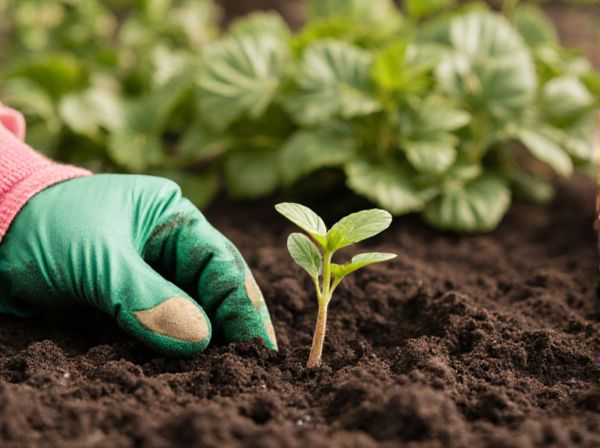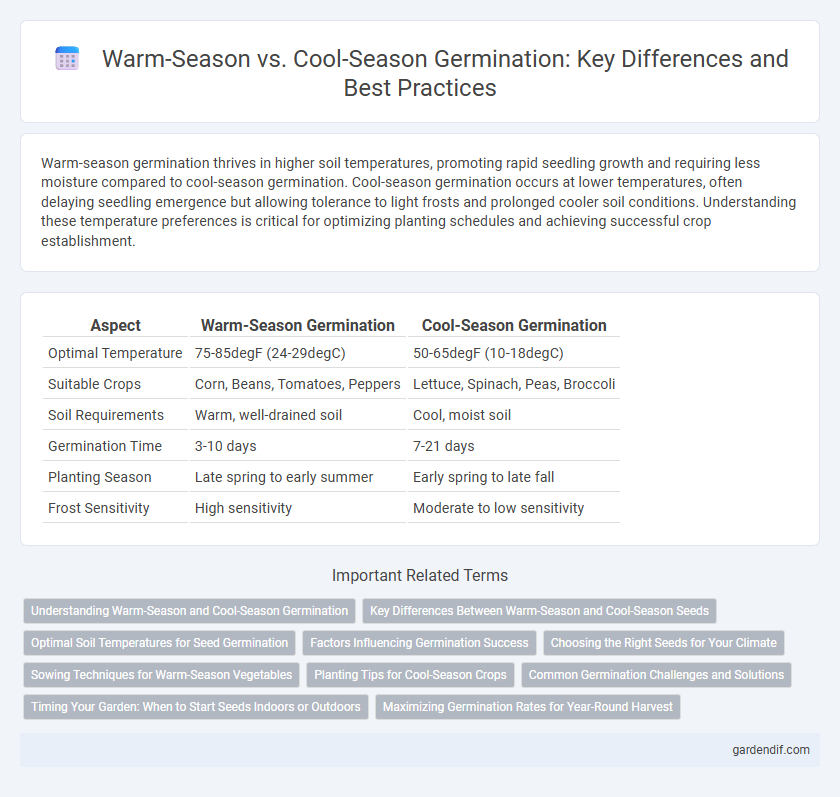
Warm-Season Germination vs Cool-Season Germination Illustration
Warm-season germination thrives in higher soil temperatures, promoting rapid seedling growth and requiring less moisture compared to cool-season germination. Cool-season germination occurs at lower temperatures, often delaying seedling emergence but allowing tolerance to light frosts and prolonged cooler soil conditions. Understanding these temperature preferences is critical for optimizing planting schedules and achieving successful crop establishment.
Table of Comparison
| Aspect | Warm-Season Germination | Cool-Season Germination |
|---|---|---|
| Optimal Temperature | 75-85degF (24-29degC) | 50-65degF (10-18degC) |
| Suitable Crops | Corn, Beans, Tomatoes, Peppers | Lettuce, Spinach, Peas, Broccoli |
| Soil Requirements | Warm, well-drained soil | Cool, moist soil |
| Germination Time | 3-10 days | 7-21 days |
| Planting Season | Late spring to early summer | Early spring to late fall |
| Frost Sensitivity | High sensitivity | Moderate to low sensitivity |
Understanding Warm-Season and Cool-Season Germination
Warm-season germination occurs optimally at soil temperatures between 70degF and 85degF, favoring seeds from crops like maize, beans, and cucumbers that require warmer conditions to break dormancy and promote vigorous sprout growth. Cool-season germination thrives at soil temperatures ranging from 50degF to 65degF, suitable for crops such as spinach, lettuce, and broccoli, enabling seeds to germinate despite lower temperature thresholds while ensuring early-season establishment. Understanding the specific temperature requirements and physiological adaptations in warm-season versus cool-season germination enhances seedling emergence success and informs planting schedules for optimal crop yield.
Key Differences Between Warm-Season and Cool-Season Seeds
Warm-season seeds require higher soil temperatures, typically between 70degF and 85degF, to initiate germination, while cool-season seeds germinate best in soil temperatures ranging from 40degF to 75degF. Warm-season seeds often have thicker seed coats and longer germination periods, adapting them to hot, dry conditions, whereas cool-season seeds germinate quickly and are suited for cooler, moist environments. These differences influence planting schedules, with warm-season crops like beans and corn planted after the last frost and cool-season crops like lettuce and spinach sown early in spring or fall.
Optimal Soil Temperatures for Seed Germination
Optimal soil temperatures for warm-season germination typically range between 70degF and 95degF, promoting rapid seed sprouting in crops such as corn and beans. Cool-season germination thrives best at soil temperatures between 45degF and 65degF, ideal for seeds like lettuce and spinach that require cooler soil conditions. Maintaining these temperature ranges ensures maximum germination rates and healthy seedling development.
Factors Influencing Germination Success
Warm-season germination thrives at soil temperatures between 70degF and 85degF, promoting rapid enzymatic activity and seed metabolism crucial for sprouting. Cool-season germination occurs optimally between 50degF and 65degF, where moderate moisture levels and oxygen availability regulate seed dormancy and enhance root emergence. Soil pH, nutrient content, and microbial activity also significantly influence germination success across temperature ranges, affecting seedling vigor and establishment.
Choosing the Right Seeds for Your Climate
Warm-season germination requires seeds such as beans, corn, and cucumbers, which thrive at soil temperatures between 70degF and 85degF, ensuring rapid sprouting and vigorous growth. Cool-season germination favors seeds like lettuce, spinach, and broccoli, which germinate best in soil temperatures ranging from 45degF to 65degF, allowing plants to establish before summer heat. Selecting seeds suited to your regional climate's typical soil temperatures optimizes germination success and promotes healthy plant development.
Sowing Techniques for Warm-Season Vegetables
Warm-season vegetables like tomatoes, peppers, and beans require soil temperatures between 70degF and 85degF for optimal germination, often necessitating direct sowing after the last frost date. Techniques such as seed starting indoors 6-8 weeks prior to transplanting or using black plastic mulch outdoors can help elevate soil temperature and improve seedling emergence. Ensuring well-drained, loose soil and consistent moisture supports faster germination and robust early growth in warm-season crops.
Planting Tips for Cool-Season Crops
Cool-season germination thrives in soil temperatures between 45degF and 75degF, ideal for crops like lettuce, spinach, and broccoli. For optimal growth, sow seeds shallowly and keep the soil consistently moist but not waterlogged to prevent rot and promote uniform emergence. Using row covers or mulch can protect seedlings from unexpected cold snaps while maintaining soil warmth and moisture.
Common Germination Challenges and Solutions
Warm-season germination often faces challenges such as soil temperatures below 70degF, leading to slow seed emergence and increased susceptibility to damping-off disease; using raised beds and soil warming techniques can enhance germination rates. Cool-season germination struggles with inconsistent moisture and risk of frost damage, which can be mitigated by selecting cold-tolerant seed varieties and applying mulch to moderate soil temperature. Both types benefit from proper seed depth and soil aeration to prevent poor seed-soil contact and ensure robust seedling development.
Timing Your Garden: When to Start Seeds Indoors or Outdoors
Warm-season germination thrives in soil temperatures between 70degF and 85degF, making late spring to early summer ideal for outdoor planting, while cool-season germination occurs optimally between 50degF and 65degF, favoring early spring or fall sowing. Starting warm-season seeds indoors 6-8 weeks before the last frost date ensures robust seedlings ready for transplanting when the soil has sufficiently warmed. Cool-season seeds can be directly sown outdoors as soon as the soil is workable, or started indoors 4-6 weeks before the last expected frost to extend the growing period.
Maximizing Germination Rates for Year-Round Harvest
Warm-season germination thrives in soil temperatures between 70degF to 85degF, optimizing enzyme activity and accelerating seedling emergence for crops like tomatoes and peppers. Cool-season germination occurs best at 45degF to 65degF, suitable for lettuce and spinach, enabling rapid root development and reducing disease susceptibility. Strategically staggering these planting periods and selecting varietals adapted to temperature ranges maximizes germination rates, supporting continuous crop production and year-round harvest cycles.
Warm-Season Germination vs Cool-Season Germination Infographic

 gardendif.com
gardendif.com